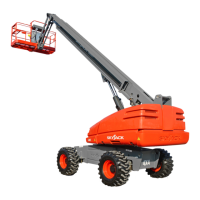Table 4.6 Floor Loading Pressure
lb. kg lb. kg psi kPa psf kPa
14,750 6,695 7,600 3,450 130 900 193 9.3
15,315 6,950 8,000 3,630 135 930 200 9.5
24,000 10,890 12,360 5,600 145 1000 330 15.8
27,200 12,340 13,900 6,300 165 1140 372 17.8
lb. kg
lb. kg psi kPa psf kPa
15,550 7,055 7,600 3,450 130 900 193 9.3
16,115 7,310 8,000 3,630 135 930 200 9.5
25,500 11,567 12,360 5,600 145 1000 330 15.8
28,700 13,018 13,900 6,300 165 1140 372 17.8
60562AH-ANSI
n
n
n
n
NOTE:
The LCP or OUP that an individual surface can withstand varies from structure to structure and is generally determined by the
engineer or architect for that particular structure.
SJ 40T
SJ 45T
SJ 61T
SJ 66T
Gross Aerial Platform Weight = Weight + platform capacity
LCP – Locally Concentrated Pressure – is a measure of how hard the aerial platform tire tread presses on the area in direct
contact with the floor. The floor covering (tile, carpet, etc.) must be able to withstand more than the indicated values above.
Total Aerial Platform Load
Wheel LCP OUP
OUP – Overall Uniform Pressure – is a measure of the average load the aerial platform imparts on the whole surface projected
directly underneath it. The structure of the operating surface (beams, etc.) must be able to withstand more than the indicated
values above.
Welder option will add approximately 350 lb. (158.8 kg) to total aerial platform weight and 175 lb. (79.4 kg) to max. wheel load.
SJ 61T
SJ 66T
MODEL
(with Air Filled Tires)
Gross Aerial Platform
Weight
MODEL
(with Foam Filled Tires)
Gross Aerial Platform
Weight
Total Aerial Platform Load
Wheel LCP OUP
SJ 40T
SJ 45T
Width
Length
Locally Concentrated Pressure (LCP):
Foot Print Area identied by test.
LCP =
Wheel Load
Foot Print Area
Overall Uniform Pressure (OUP):
Base Area = Length x Width
OUP =
Aerial Platform Weight + Capacity
Base Area
Foot Print Area
Page 74
SJ 40T & SJ 45T
SJ 61T & SJ 66T

